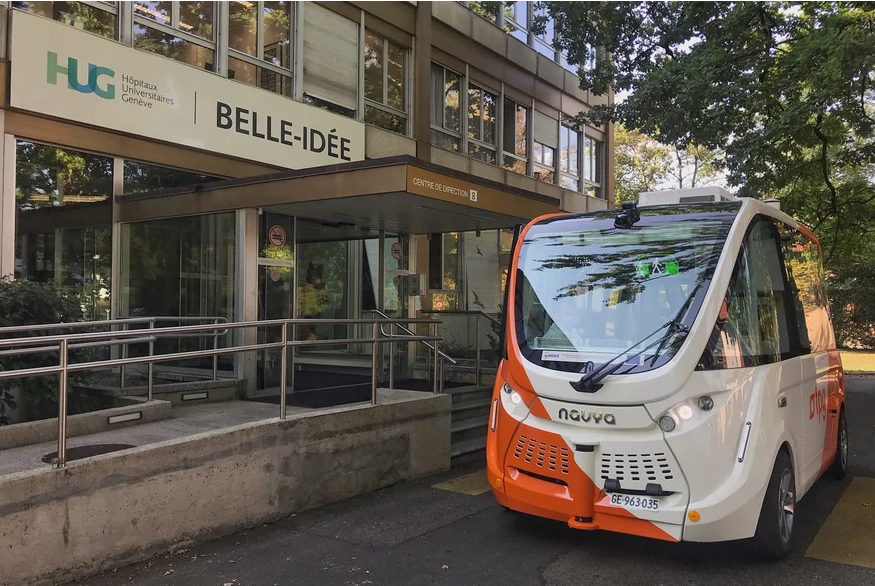When the Belle-Idée project is fully up and running, three shuttle buses will offer a 24-hour on-demand door-to-door service at the Geneva hospital site. swissinfo.ch Over the past five years, various kinds of autonomous vehicles, including buses, have popped up on Swiss roads. But though testing continues, a driverless future might yet be some years away. On a crisp autumn morning in the Geneva countryside, a bright orange-and-white electric bus is winding through the leafy 36-hectare grounds of the Belle-Idée hospital site. The bus is trundling along a gravel path when suddenly a patient and a nurse step out from behind a tree. The vehicle brakes sharply, a bell rings out, a “keep your distance” sign flashes at the front and rear. The couple steps back, and the
Topics:
Swissinfo considers the following as important: 3.) Swiss Info, 3) Swiss Markets and News, Business, Featured, Lifestyle, newsletter
This could be interesting, too:
Nachrichten Ticker - www.finanzen.ch writes Die Performance der Kryptowährungen in KW 9: Das hat sich bei Bitcoin, Ether & Co. getan
Nachrichten Ticker - www.finanzen.ch writes Wer verbirgt sich hinter der Ethereum-Technologie?
Martin Hartmann writes Eine Analyse nach den Lehren von Milton Friedman
Marc Chandler writes March 2025 Monthly

When the Belle-Idée project is fully up and running, three shuttle buses will offer a 24-hour on-demand door-to-door service at the Geneva hospital site. swissinfo.ch
Over the past five years, various kinds of autonomous vehicles, including buses, have popped up on Swiss roads. But though testing continues, a driverless future might yet be some years away.
On a crisp autumn morning in the Geneva countryside, a bright orange-and-white electric bus is winding through the leafy 36-hectare grounds of the Belle-Idée hospital site.
The bus is trundling along a gravel path when suddenly a patient and a nurse step out from behind a tree. The vehicle brakes sharply, a bell rings out, a “keep your distance” sign flashes at the front and rear. The couple steps back, and the bus continues slowly on its way.
The toy-like shuttle – empty apart from a safety operator and guided by sensors, GPS and radar – is the centrepiece of a unique driverless public transport experiment.
“It’s a world first for a public transport service,” says Dimitri Konstantas, director of the Information Science Institute at the University of Geneva, who is helping to coordinate the project. “Most sites and lines have a fixed route… but here the difference is that there is no route. You can go anywhere.”
Testing, testing
This summer, a small team began testing the ten-seater vehicles, mapping out the huge Belle-Idée park and its obstacles. In parallel, a Geneva-based start-up, MobileThinking, has been putting the finishing touches to an app that will be tried out by the first passengers before the end of the year.
Then when the project is up and running in the next couple of years, patients, visitors and staff will be able to get around the sprawling complex by using their smartphone to order one of three buses offering a 24-hour on-demand door-to-door service.
Users will be able to locate a bus via the app, then send a pick-up request. Software will indicate when a bus is available and what the journey time will be. A fleet management system will then adapt the vehicle’s route according to other passenger requests.
The idea is to have a completely automated system with a safety operator back at a central depot monitoring the vehicles, says Jeroen Beukers, an autonomous vehicle expert who is running the project for the Geneva public transport authorities (TPG).
“Next week we are installing electric doors on the bus depot. In the future, you’ll make a booking on your phone, the depot doors will open automatically, a charged bus will pick you up from A and take you to B and then either return to the depot or continue onwards to pick up someone else,” he says.
European project
The project is not Geneva’s first driverless bus trial: TPG has been successfully running an automated shuttle on a fixed circular route in Meyrin since 2018.
The Belle-Idée project was selected as part of a four-year European driverless vehicle initiative known as AVENUE (Autonomous Vehicles to Evolve to a New Urban Experience). The European consortium, funded by the European Union’s Horizon 2020 programme, includes pilot schemes in Lyon (France), Luxembourg and Copenhagen (Denmark).
Driverless vehicles in Switzerland
Switzerland has been testing several different kinds of driverless vehicles on its roads over the past five years. An autonomous passenger car was tested in Zurich in 2015, followed by a delivery robot in Bern a year later. These tests have now been completed.
In Sion, canton Valais, a trial using an autonomous Swiss Post bus in the town centre began in summer 2016 and was later adapted and extended. But the project has been suspended due to the Covid-19 pandemic. Swiss Post is planning a follow-up project between Sion and the village of Uvrier.
Regional public transport companies are also testing autonomous shuttles in Marly (canton Fribourg), in Bern, and in Meyrin and Thônex (canton Geneva). Similar trials were done in Neuhausen am Rheinfall (2018-2019) near Schaffhausen, and in Zug (2018-2019).
Over the past five years a growing number of other Swiss cities and transport companies have experimented with driverless vehicles on fixed routes (see infobox). This includes Sion, the capital of canton Valais, which in 2016 became the first Swiss city to launch an autonomous bus service in collaboration with Swiss Post.
Apart from the odd minor accident, the results of these trials have been generally positive, with thousands of passengers now regularly taking driverless shuttles.
Swiss ‘pioneer’
The trials have allowed Switzerland “to position itself as a pioneer” in this field, according to Marina Kaempf, spokesperson for the Federal Roads Office.
In most cases the tests were well accepted by the public, with municipalities and cantons developing “realistic” projects to show what the vehicles can do, she tells swissinfo.ch.
But current technologies still don’t allow vehicles that are 100% driverless – i.e. without a safety operator – to be used commercially, the Roads Office says. The exchange of data between driverless vehicles and the outside environment also needs to be improved.
“Longer term, you can imagine driverless buses running more permanently on certain lines when their technologies have been perfected,” says Kaempf. But in the short-term, while autonomous pilot schemes will continue in their current form, the Roads Office is not planning to increase them or turn them into commercial ventures.
Meanwhile, in parallel to these trials, the government is gearing up for the wider use of driverless vehicles on Swiss roads in the coming years. In August, it launched a consultation process to revise the Federal Law on Road Traffic. Part of the proposal aims to improve the legal basis for automated driving and future testing, and to ensure Switzerland can adapt to any international developments in this field.
Huge challenges ahead
Despite Switzerland pushing ahead, not all mobility experts are convinced by driverless buses.
“Maybe they’ll have made big progress in 20 years, but at the moment autonomous buses are a bit of a gadget,” says Vincent Kaufmann, a professor at the Federal Institute of Technology Lausanne (EPFL) and scientific director of the Mobile Lives Forum in Paris.
“What’s interesting is not so much driverless buses, but shared autonomous vehicles, like taxis. We’ll continue to need trams, trains and buses, where you carry 100-200 passengers. But if the shared autonomous vehicle can replace the individual car in the city that’ll be a real gain.”
Driverless challenges – both regulatory and technical – remain huge, raising many questions. Will the introduction of autonomous buses, taxis and privately-owned driverless vehicles just clog up the roads if they are not correctly regulated? How safe will such vehicles be? Will autonomous buses be used downtown or just in suburban areas? How will private data used by autonomous vehicles and passengers be protected? What legal responsibility will public transport firms and drivers have for their autonomous vehicles?
At the technical level, Konstantas feels driverless vehicles still have a long way to go before they can correctly identify objects and anticipate people’s behaviour in the streets.
“Tesla is working on it, but I doubt they’ll be able to do that within 15-20 years,” he says.
He also sees data protection as a big issue. “We’re not allowed to use the data of people walking around in order to learn from it,” he says. “Our system is programmed. It’s not dynamic learning or AI – we don’t have that yet.”
“What we’re doing here is experimental. Is it possible to build the future? We don’t know. Is this going to be useful or not? We don’t know. But we’re going to try.”
Tags: Business,Featured,Lifestyle,newsletter








